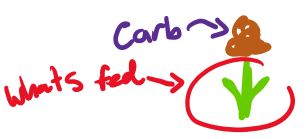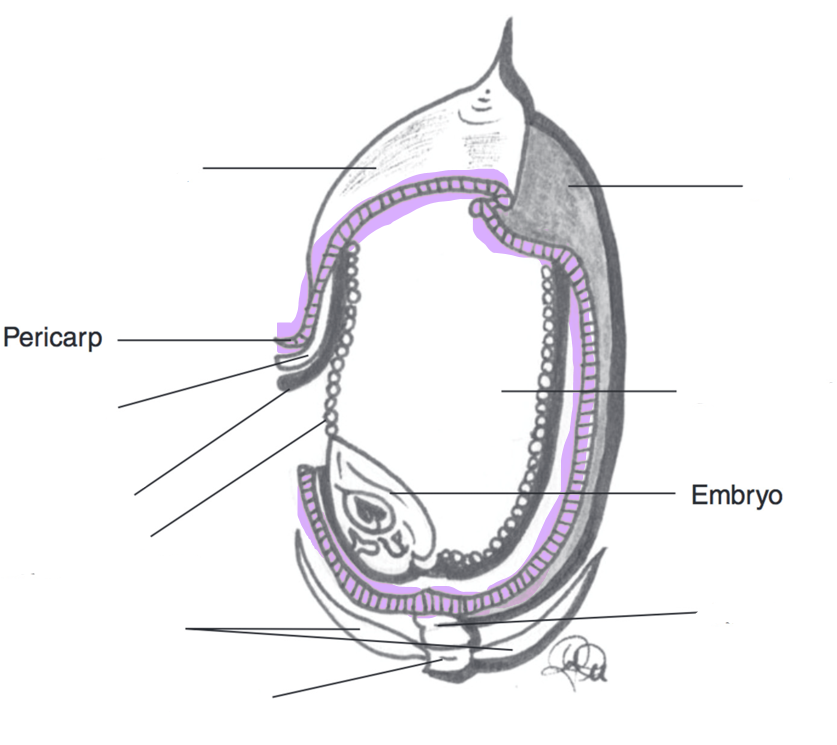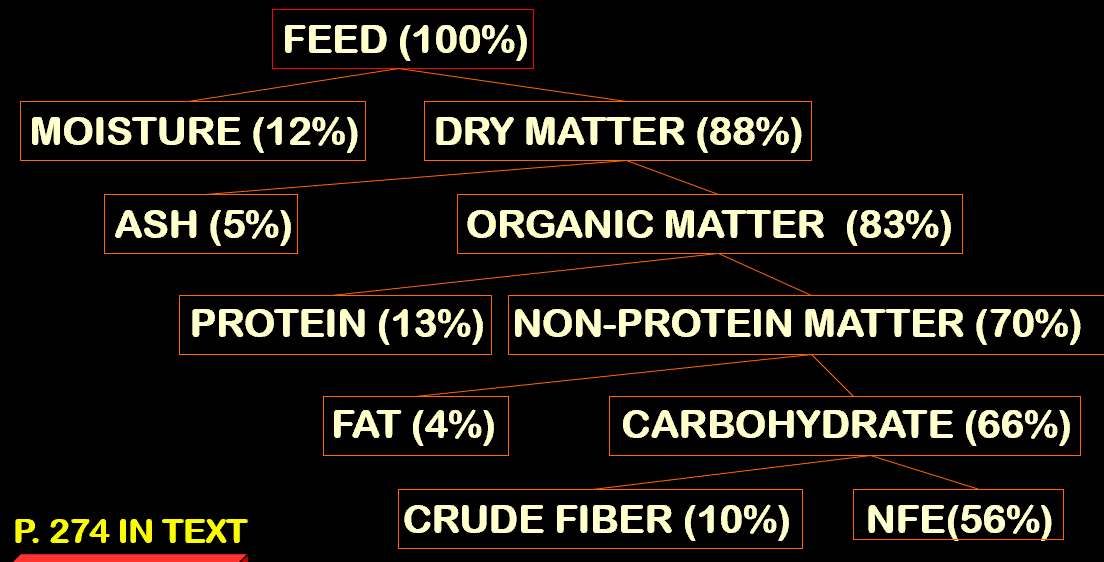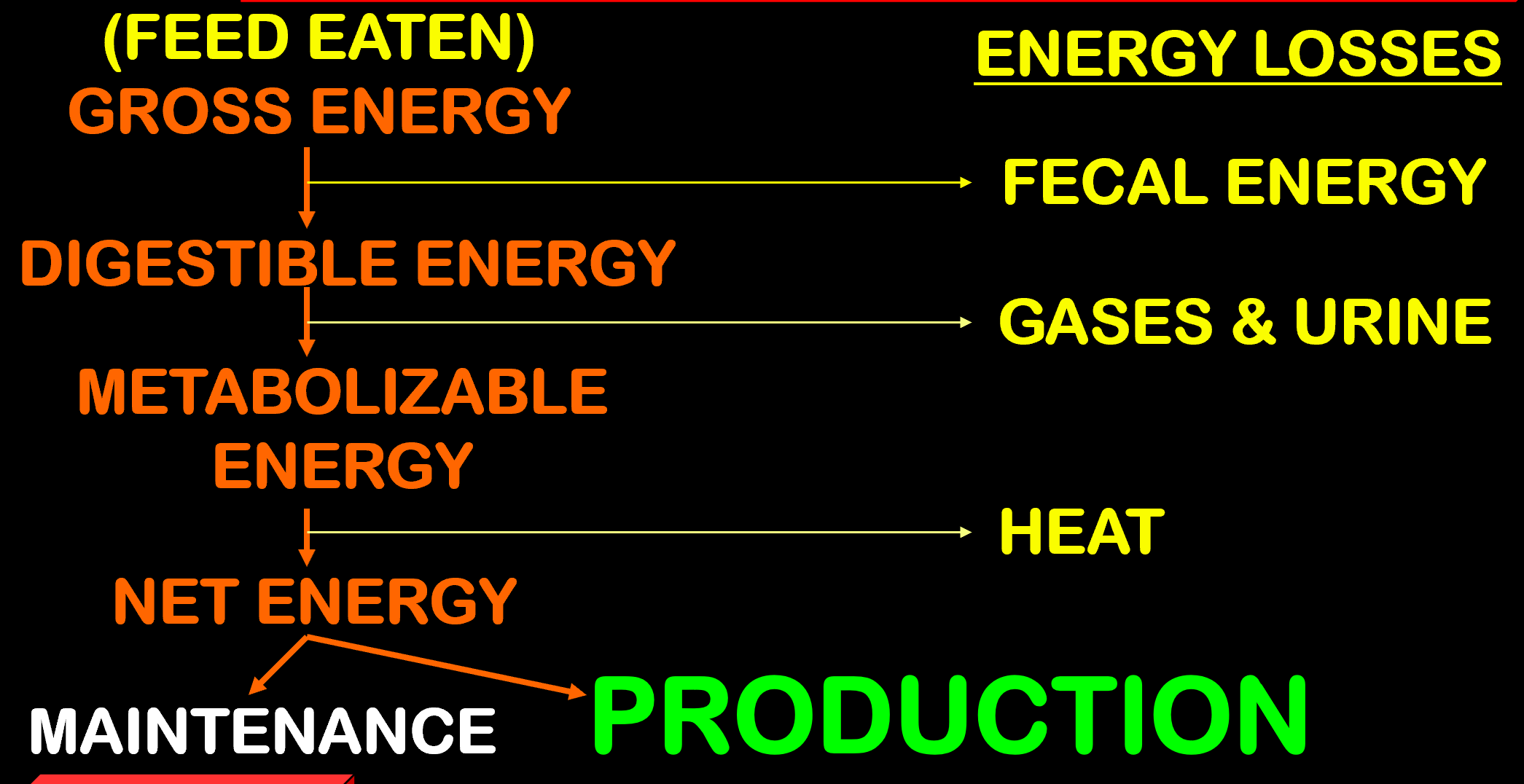ANSC 1401 - Nutrition
1/79
Earn XP
Description and Tags
Dr. Jackson
Name | Mastery | Learn | Test | Matching | Spaced | Call with Kai |
|---|
No study sessions yet.
80 Terms
Why do we need nutrients?
To meet all animal requirements
Offspring, maturity, gestation, lactation, adult, etc
Single most relevant cost
Prevents failures in the body
Diseases, infertility, lack of milk, etc
A lack of knowledge can lead to poor livestock
What are Concentrates?
Grains
High in energy (Caloric) ▲
Low in fibre ▼
Highly digestible ▲
What are Roughages?
Grasses & hay
Low in energy ▼
high in fibre ▲
Lowly digestible ▼
Carbonaceous Concentrates
Low in protein ▼
Primary Sources: Cereal grains (corn, wheat, oats, sorghum)
Corn 1st most popular
Sorghum 2nd most popular
Starch is a carbohydrate and is fed for energy
Typically consumed by swine & poultry
Digested easily by monogastrics
Nitrogenous Concentrates
High in protein ▲
Primary sources: Soybean meal, cottonseed meal, tankage, dairy products
Dairy is easily digested by young
Tankage: leftovers from a slaughter fed back to livestock
No longer fed due to linkage to mad cow disease
Cottonseed hulls used on forage cattle
Tends to be easier on the ruminant stomach
Must mind the amount consumed due to gossypol
Carbonaceous Roughage
Low in protein ▼
Primary sources: mature grass, grass hay, hay, or stover
Hay will be sold by the bale or by the ton; however, a balance of quality & quantity matter
Not too old to where there is no nutritional value but not too young where there isn’t much hay to be sold
NOT EASILY DIGESTED
Carbs will grow up the stem as a plant matures
Stems are what will be fed to the animals and will not have a high concentration of carbohydrates

Nitrogenous Roughage
High in protein ▲
Primary sources: growing pasture, silage, legume hay
Cost will range depending on quality
Only mature cattle can do well on low-quality forage
Gin trash is a great energy source for ruminants
Gin trash and the used parts of cotton plants
Ruminants can use low quality roughages
What are the parts of a Grain Kernel?
Germ/Embryo: genetic makeup of the grain; protein found there
Starch: makes up the majority of the kernel & is a carbohydrate
Pericarp: the protective covering of the grain. Needs to be cracked/crushed/rolled/steam-flaked to allow digestion

Why are Feed Rations (Roughages) Pelleted?
Improves digestibility
Easier to transport
Pack more in
Stores easier
Can easily mix with other feed
Nutrients in Feedstuffs
Water: Most essential
Die quickly without
Protein: Needed for cell repairs
Supplements are expensive
Carbohydrates: Main energy source
Lipids (fats & oils): Functions as insulation and protection
2.25 x Energy
Vitamins: Organic Catalysts
Minerals (Ash): A crude measurement of elements that don’t burn
Feed additives: Stimulates growth
Relative Amount of Nutrients in a Feed
Need to memorize this chart!
NFE = Nitrogen-Free Extract

Water
Not necessarily the cheapest anymore, but is the most abundant
Abundant in places that do not benefit anyone (the ocean)
Scarce when and where it is needed the most
Obtained via drinking, ingested with feed, metabolic (nutrient breakdown)
Functions of Water
Regulates temperature through saliva/sweating
Transports nutrients & excretions
Maintains cell shape
Lubricates & cushions joins (synovial fluid contains water)
Proteins
Building blocks are Amino Acids
Two categories: Essential and Non-essential
Need to know: Histidine, Isoleucine, Leucine & Lysine (HILL); essential
Lysine
Most common amino acid
Most limiting amino acid
Involved in growth, tissue repair, collagen production
Must be supplied through supplementation
Average Protein Content
Equation to determine: Nitrogen x 6.25
An avg of 16% Nitrogen is found in Protein
Do not need to convert in equation…
Feedstuff analyzed 1.92% N, 1.92 × 6.25 = 12% crude protein
What is Digestible Protein?
The amount of crude protein that can actually be digested
Non-Protein Nitrogen (NPN)
A substance containing Nitrogen that is NOT a part of an amino acid
Only fed to ruminant animals
Microbes in a rumen can use an NPN as a nitrogen source
Example: Urea
Protein Functions
Basic structural unit of animal and human bodies
Bodily metabolism (enzymes, hormones, anti-bodies, hereditary transmission structures—all require proteins to function properly)
Energy Source
If more protein is consumed than needed, it will be stored as fat or excreted
Carbohydrates
Created in plants via photosynthesis
6CO2 + 6H2O → C6H12O6 + 6O2
Requires Chlorophyl and 673 calories of radiant energy
Carbohydrates: Monosaccharide
1 unit of sugar
Glucose
Most important
Fructose
Galactose
Carbohydrates: Disaccharide
2 simple sugars
Sucrose: Glucose + Fructose
S = G + F
Maltose: Glucose + Glucose
M = G + G
Lactose: Glucose + Galactose
L = G + Gal
Carbohydrates: Trisaccharide
3 simple sugars
Raffinose: Glucose + Fructose + Galactose
R = G + F + G
Carbohydrates: Polysaccharide
Long chain or branched molecules of several disaccharide subunits
Starch & Amylopectin: Easily digested by all digestive systems
Cellulose: Only digested by ruminant microbes
Lignin (wood): Only digested by termites
Carbohydrate Functions
Energy
Provide enough energy for the body to heat itself
Will be stored as fat is more than what is needed is consumed
Components of Energy Chart
Need to memorize this chart!

Digestibility of Feedstuff Equation
(Feed Consumed – Feed Excreted/Feed Consumed) X 100

Total Digestible Nutrients (TDN) Formula
Digestible Protein + Digestible Crude Fiber + (Digestible Fat x 2.25) + Digestible Nitrogen-Free Extract
Just know that you NEED to multiply fat by 2.25 then add them all together
Lipids (Fats & Oils)
Lipids are made of Fatty Acids & Glycerol
Saturated fats like lard & beef tallow will be solid at room temperature
Unsaturated fats like cottonseed oil & corn oils will be liquid at room temperature
How many calories do Lipids provide? Proteins & Carbs? How do they compare?
Lipids provide 9 calories
Proteins & Carbs provide 4 calories
This creates a ratio of 9 to 4 (9:4)
Essential Fatty Acids & Deficiency
Cannot be produced on their own and must be supplied in the diet
Fatty Acids to make note of: Linoleic, Linolenic & Arachidonic
A deficiency in Fatty Acids will cause skin conditions/diseases
Reproduction is dependent on fat
What are the functions of Lipids?
Energy
Will also be stored as fat if too much is consumed (best energy source!)
Insulation
Keeps heat in
Protects internal organs
Carries fat-soluble vitamins: D, E, A, K
What is Hydrogenation? Why do we do it?
Most oils will be partially hydrogenated which lowers their unsaturated fatty acid content, making them saturated
Lowers pH and melting point
If unsaturated oils are not hydrogenated, they will not be usable for too long because a rancid flavor & odor will develop
How do we determine fat content?
We use Ether extraction because fats are soluble
Cattle, Sheep, and Swine… Rank from most fat to least
Swine
Swine have the most subcutaneous fat which compensates for not having a lot of hair
Cattle
Cattle have a good balance of fat and hair
Sheep
Sheep’s wool compensate for their lack of fat
Vitamins
Vitamins are organic catalysts that function in biochemical reactions
The animal body only needs small amounts
They are split into 2 categories:
Fat Soluble: D, E, A, K
Water Soluble: Vitamin C, B-Complex, B12
Vitamin D
Aids in Calcium absorption from the gut
Bodies can manufacture it from sunlight
Deficiencies can lead to skeletal diseases such as Rickets
Vitamin E
Has antioxidant properties which help reduce free radicals which enhances an animal’s immunity
May help delay the effects of Alzheimer’s
Deficiencies can lead to muscle atrophy and reproductive issues
Vitamin A
Found in dark leafy greens which can be affected by the seasons
They help with eyesight & night vision
Deficiencies will lead to blindness
This is caused by the constriction of the optic nerve by the skull; the nerve will grow but the skull remains the same
Vitamin K
Necessary for blood clotting and can help with rat poison
Not many deficiencies but excessive bleeding can occur with injury
K for Clot
Vitamin C
Found in citrus fruits (lemons, oranges, etc.) & forages
Used for collagen formation
Deficiencies can cause bone/skin issues due to lack of collagen formation
B-Complex
Most function as coenzymes in oxidative metabolic reactions
Prevent several disease conditions
Nerve disorders, goose stepping, bad skin & hooves, retarded growth, seizures, etc
B12
Main food source is meat & dairy
Aids Calcium and Magnesium
Cattle have a rumen bacterium that produces it
Deficiencies can lead to anemia
Minerals
Don’t act alone
Balance is as critical as the amount in the diet
Components of hormones & enzymes
Help maintain a cell’s osmotic pressure & pH levels
Animals need salt to obtain Na & Cl, otherwise, they’ll gain slowly and inefficiently
Mineral Classifications
Macro is needed in large amounts
Ca, P, Na, Cl, Mg, K & S
CaNa PCl, Mg KS
Can a pickle, magnesium kiss
Micro is needed in small amounts
Fe, Cu, I, Co, Zn, Mn, Se, Mo & F
Calcium vs Phosphorus Ratio
2:1 ratio (Ca:P) when feeding
Prevents urinary calculi in male ruminants
Forage animals need Phosphorus supplemented
Feedlot animals need Calcium supplemented
Calcium (Ca)
Plays a role in bone strength & density
Deficiency will cause weak bones
Prone to Rickets and Osteoporosis
Phosphorus (P)
Deficiency will cause a decrease in appetite paired with lack of growth
Rickets and impaired reproduction in cattle
Iron (Fe)
Found in hemoglobin molecules
Proteins found in red blood cells that carry O2
A deficiency will cause anemia
Baby swine will need supplementation
Iron found in dirt
Copper (Cu)
Sheep are highly prone to copper toxicity as it accumulates in their liver
Deficiency will cause bone abnormality, ataxia, and abnormal hair/wool development
Iodine (I)
Needed for the synthesis of Thyroxin, the Thyroid hormone
Deficiency will cause a condition called Goiter
Goiter is the inflammation of the thyroid gland
Cobalt (Co)
Required for B12 synthesization
Deficiency will cause anemia
Zinc (Zn)
Deficiency will cause Parakeratosis
Irritated, coarse and rough skin
Manganese (Mn)
Required for bone and cartilage formation
Deficiency will cause weak/deformed bones and eggshells
Selenium (Se)
Present in all body cells
Highest amounts in liver, kidneys, and muscles
Deficiency can cause lameness and paralysis
Fluorine (F)
An excessive intake will cause Flourine Toxicity
Chalky and mottled teeth caused by Fluorosis
What is the purpose of Feed Additives?
Promote growth
Reduce stress
Increase palatability
Add bulk
Preserve other feeds in diet
What are the biggest feed additives?
Growth stimulants
Increases rate of growth, feed efficiency & lean meat yield
Antibiotics
Reduces health issues, increases rate of growth & feed efficiency
Animal Classifications
An animal will be one of three classifications
Carnivore
Herbivore
Omnivore
What an animal consumes will typically determine which category it will end up in
Carnivores
All carnivores are monogastric
Carnivores eat meat
Examples: Dogs and Cats
Herbivores
Herbivores can be both monogastric & ruminants
Herbivores eat plant tissues
Examples: Horses, Rabbits, Cattle, Sheep & Goats
Goat, Sheep, and Cattle are ruminants
Omnivores
Omnivores are monogastric
Omnivores eat both meat & plant tissue
Example:
Swine
Digestion
Prepares food for absorption by gut
Forces of Digestion
Mechanical
Chewing
G.I. tract muscle contractions
Chemical
G.I. tract produces enzymes
Microorganism digest feedstuff (ruminants)
HCl is produced in the Abomasium
What affects digestion?
Temperature: Animals will do better in the cold
The rate of passage: Animals will absorb more at a slower rate
Physical form of feed: Cracking/pelleting can increase digestibility
Heating feed: it can increase digestibility
Antibiotics: will reduce harmful bacteria & bugs
The Mouth
Will break down feed with chewing to swallow
The Esophagus
Carry food to stomach
The Stomach
Only for monogastrics
Release HCl to break chemical bonds
The Small Intestine
All nutrients except complex carbohydrates & water are absorbed into the bloodstream
The Large Intestine
Water & complex carbohydrates are absorbed while waste begins to form
The Rectum
Waste exits the body
The Rumen
Fermentation vat
The largest of the 4 compartments
Feed travels into large chunks to the rumen to be stored until fermentation
With the help of Reticulum, boluses are stored to be rechewed & swallowed where they are then fermented and have nutrients (Cellulose) utilized by the microbes & bacteria
This is a defense mechanism ruminants have as they are prey animals
Reticulum
Aids in regurgitation
Once feed is rechewed with saliva, it will travel to the Reticulum as smaller chunks where they get filtered
Sometimes, cattle will chew foreign objects, and the Reticulum can stop them from passing any further
Honeycomb shaped
Omasum
Water is absorbed in the bloodstream
Nicknamed the “Butcher/Stockman’s Bible” because of its many folds making it look like a large book
Abomasum
“True Stomach”
Anzymes & acids begin to chemically break down the feed by breaking its chemical bonds
HCl is produced
What do young ruminants have? What does it do?
Calves, Kids & Lambs will consume milk through an esophageal groove that shunts milk directly to the abomasum
What teeth do ruminants lack?
Upper incisors
Which animal utilizes their cecum the most?
Horses
Hindgut fermenters
Does the cecum, rumen, or both have a large population of bacteria?
Both
Does corn or hay store better in winter?
Corn